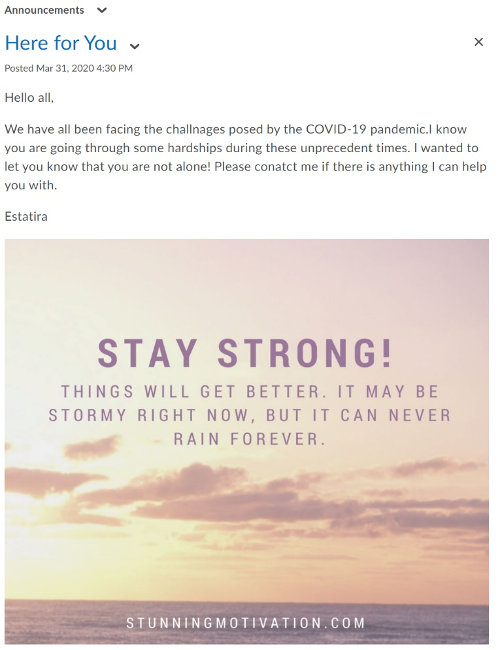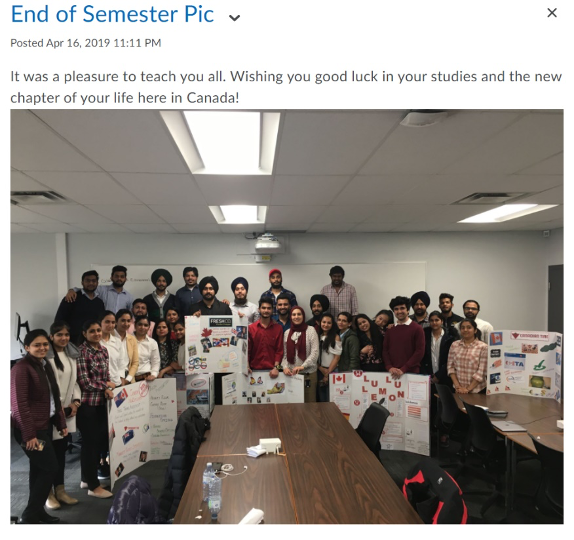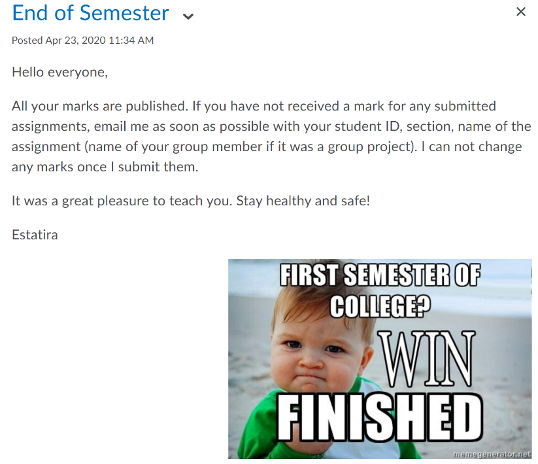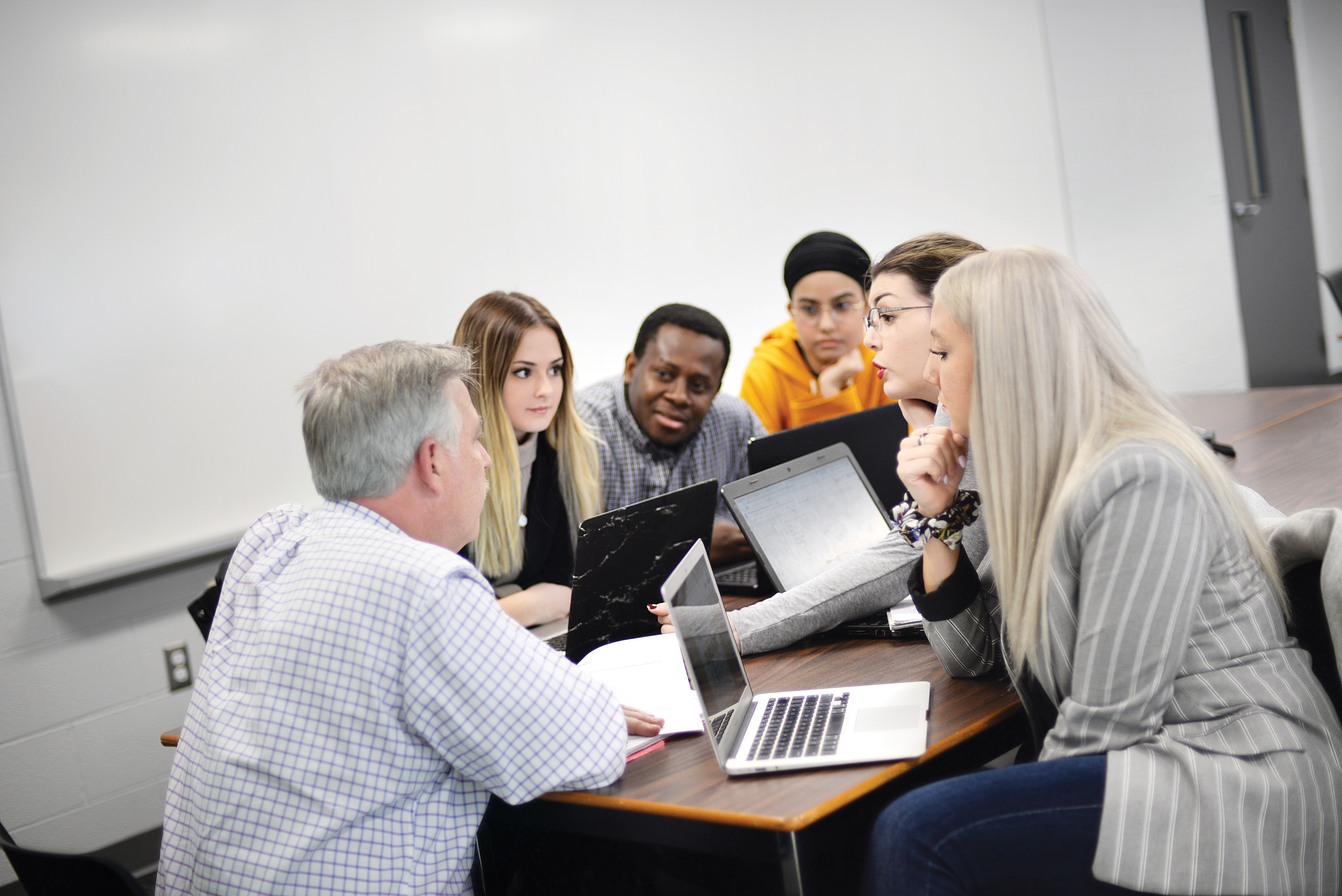Connecting With Students is Key For Online Synchronous Learning This Fall
By Estatira Shirkhodaee
Estatira Shirkhodaee is the program coordinator for Business-International Business, and has taught international business, marketing, and other courses for over 20 years. She uses her marketing and business expertise to advocate for equality, education, and women’s rights. This Teaching Story shares advice and examples of visuals for connecting with students.

When I first started as a part-time faculty member at Conestoga, I developed close interactions with students in the face-to-face classroom to create an environment in which everyone felt comfortable. This meant setting clear expectations, but also listening and understanding where students are coming from. Emotional intelligence is a big part of my success as a certified ESL teacher in Canada and in the Middle East, as president of a women’s rights organization, and as an educator on marketing and international business.
Also, I didn’t hesitate to make things I felt my students needed. I developed sample questions and created new visuals and other resources beyond what was currently available. Drawing from my marketing background, taking PD about topics I felt a passion for, and I applied my knowledge to make new and different learning materials to benefit my students’ learning.
Now, as a program Coordinator, I know that without face-to-face interaction online synchronous classes this fall will be challenging. That’s why it is so important that faculty maintain a close connection with students to help them be successful.
Provide Clear Communication to Students
I believe that faculty need to go “full gear” at the beginning of the semester. Language is a big challenge for some students, so it is important to be clear and straightforward about your expectations. Say to students: “Do not cheat. Do not plagiarize. Follow the due dates. These are the red lines.”
Don’t overpromise. When I send messages about assignments, I let students know exactly how I can help them, and how I can’t because they must take responsibility for their work.
But although I appear serious, I do everything I can to help students past the finish line. I keep track of student progress, and when I see students lagging I partner them with strong students. I remind students to write down assessment dates. It seems like spoon-feeding, but I do it because most of my students are not used to writing things down in a calendar.
I will ensure that my students know where they are standing by the end of term. They will get plenty of feedback, and even second chances, but not every time. Embracing failure is a part of life. If a student fails, I will explain to them that it’s a learning lesson, but it is not the end.
Connect with Students
I strive to connect with my students online in a number of ways. I post a brief note and a picture for occasions like Canada Day or International Women’s Day, or when there is a holiday that my students celebrate. In these Announcement I empathize with students, saying that they must miss their families, especially on these holidays.

I also talk about examples that relate to their lives, such as how to stand up for themselves when they experience racism in Canada. I tell them be assertive but not aggressive, and refuse to be disrespected because you are equal in this country. I tell them stories of how I responded when I experienced racism. My stories help students to make sense of the world around them, and find their place within it, especially those students who plan to make a life in Canada.
I even share stories of my own past successes and failures because it opens up a conversation. I can understand that some faculty may be hesitant to share personal information, or show vulnerability, because they worry that students will take advantage of them. But having a clear channel of communication, and strong connections with students, means you can be vulnerable but still in charge at the same time.
Listen to Students
My students come from countries who negotiate not just over grades but over everything. When they ask for better grades, I know that they are not targeting me personally, so I listen and then I respond in an honest, straightforward way.
As faculty, we need to show them we are prepared to hear them out. There are lines that we cannot cross, and things we cannot do, but we can let them know that we do our best to help them, and that we will always listen.
It can seem like a lot of time to invest in listening to students, but I believe it is worth investing time to create safe environment and clear expectations. Doing so also saves time later. When we have a good relationship, students come to me with their challenges. I can hear their concerns, but I don’t let the students manipulate me.
Recently, I had a student who told me she thought she might have COVID-19. She didn’t want to tell anyone because she believed there was a stigma. I said that I appreciated that she told me, then described a time I had to overcome my fears and get help when I needed to because it was best for me. We cannot understand the experience of our students, but we can empathize.

Setting Fall Teaching Goals
One of my teaching goals right now is to enhance my computer skills this fall. Because I am ambitious and always want to do better, I would like to use new technology to ensure that the activities in my remote classes to go as well as they did in in the face-to-face classroom.
I plan to use video and audio recorded messages a lot in my teaching, as I know students will appreciate being able to review them multiple times.
My second goal is to track student progress and check in on particular items each week. I will pay close attention to vulnerable students and those who failed some courses. Technology will help me create a timeline I can follow.
Finally, I’m going to continue to not give up on my students—because people deserve second chances, in school and in life. In high school, I was naughty. I questioned everything. I had a lot of spirit, and I didn’t want to be dominated, so I always spoke my mind. When I think back, I realize that I had teachers who were very patient with me. They never gave up on me, and that experience taught me a lot.
So, as the semester starts I will be mindful of continuing to highlight the good qualities in my students, as my teachers did with me. Doing so will give them confidence. And if they have confidence, they will learn.
Advice to Faculty Teaching Remote Classes This Fall
- Develop your emotional intelligence and apply it to your classroom activities.
- Don’t be afraid to be vulnerable. Discomfort is an opportunity to grow.
- When you speak with students, be serious about your expectations but understanding about their challenges.
- Create relationships by talking about everyday life issues, even food. Play music.
- Fear paralyzes students, and they can fail to speak up and at when they need to. When students tell you things, empathize then direct them to the right resources.
- Video recordings take time, but they save time. Make a video or an audio message and post it online with very clear expectations. Give advice about the importance of time management, study habits, and routines. Reinforce instructions verbally.
- Don’t be scared to try something new, or even to act goofy or silly. Be cheerful, and cheer students up. Learning happens better if you are in a good mood.
- Ask students what they expect from us, and what we can do for them, as faculty. Maybe what they say will be unrealistic, but they may have suggestions that will be quite helpful.
Gallery of Announcements for Students
View this gallery for examples of eConestoga Announcement messages with visuals providing celebration, support, and encouragement to students.

An Announcement message to students acknowledging their participation in a day of activism. Reproduced with students’ permission. 
An Announcement message to students celebrating Thanksgiving 
An Announcement message to students with a picture of the class following group presentations. Reproduced with permission. 
An Announcement to students with a message of support for students during COVID 19. 
An Announcement message to students celebrating Diwali. 
An Announcement message to students with a meme celebrating the end of term. 
An Annoucement with a message of celebration on Canada Day



